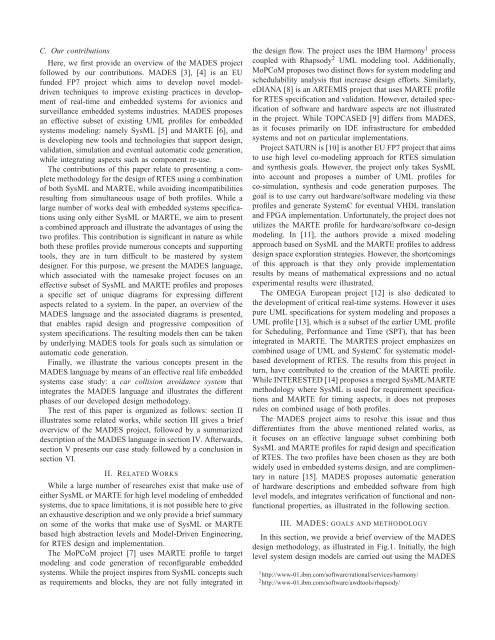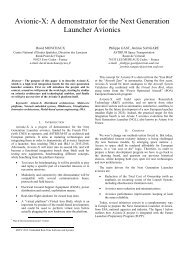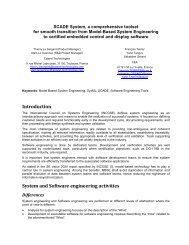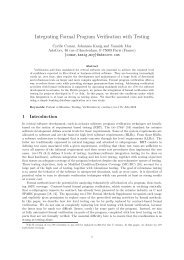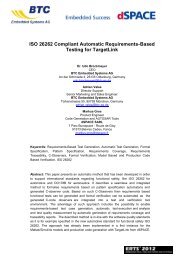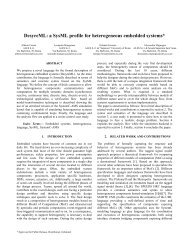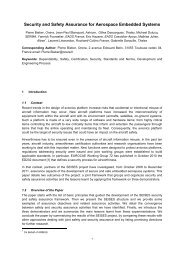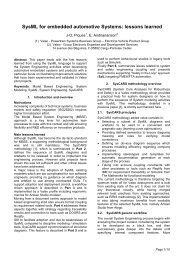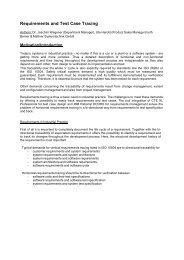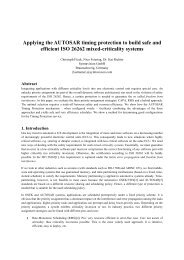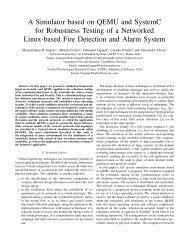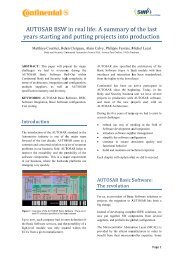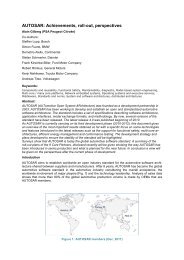A SysML/MARTE high level methodology for real-time - Embedded ...
A SysML/MARTE high level methodology for real-time - Embedded ...
A SysML/MARTE high level methodology for real-time - Embedded ...
You also want an ePaper? Increase the reach of your titles
YUMPU automatically turns print PDFs into web optimized ePapers that Google loves.
C. Our contributionsHere, we first provide an overview of the MADES projectfollowed by our contributions. MADES [3], [4] is an EUfunded FP7 project which aims to develop novel modeldriventechniques to improve existing practices in developmentof <strong>real</strong>-<strong>time</strong> and embedded systems <strong>for</strong> avionics andsurveillance embedded systems industries. MADES proposesan effective subset of existing UML profiles <strong>for</strong> embeddedsystems modeling: namely <strong>SysML</strong> [5] and <strong>MARTE</strong> [6], andis developing new tools and technologies that support design,validation, simulation and eventual automatic code generation,while integrating aspects such as component re-use.The contributions of this paper relate to presenting a complete<strong>methodology</strong> <strong>for</strong> the design of RTES using a combinationof both <strong>SysML</strong> and <strong>MARTE</strong>, while avoiding incompatibilitiesresulting from simultaneous usage of both profiles. While alarge number of works deal with embedded systems specificationsusing only either <strong>SysML</strong> or <strong>MARTE</strong>, we aim to presenta combined approach and illustrate the advantages of using thetwo profiles. This contribution is significant in nature as whileboth these profiles provide numerous concepts and supportingtools, they are in turn difficult to be mastered by systemdesigner. For this purpose, we present the MADES language,which associated with the namesake project focuses on aneffective subset of <strong>SysML</strong> and <strong>MARTE</strong> profiles and proposesa specific set of unique diagrams <strong>for</strong> expressing differentaspects related to a system. In the paper, an overview of theMADES language and the associated diagrams is presented,that enables rapid design and progressive composition ofsystem specifications. The resulting models then can be takenby underlying MADES tools <strong>for</strong> goals such as simulation orautomatic code generation.Finally, we illustrate the various concepts present in theMADES language by means of an effective <strong>real</strong> life embeddedsystems case study: a car collision avoidance system thatintegrates the MADES language and illustrates the differentphases of our developed design <strong>methodology</strong>.The rest of this paper is organized as follows: section IIillustrates some related works, while section III gives a briefoverview of the MADES project, followed by a summarizeddescription of the MADES language in section IV. Afterwards,section V presents our case study followed by a conclusion insection VI.II. RELATED WORKSWhile a large number of researches exist that make use ofeither <strong>SysML</strong> or <strong>MARTE</strong> <strong>for</strong> <strong>high</strong> <strong>level</strong> modeling of embeddedsystems, due to space limitations, it is not possible here to givean exhaustive description and we only provide a brief summaryon some of the works that make use of <strong>SysML</strong> or <strong>MARTE</strong>based <strong>high</strong> abstraction <strong>level</strong>s and Model-Driven Engineering,<strong>for</strong> RTES design and implementation.The MoPCoM project [7] uses <strong>MARTE</strong> profile to targetmodeling and code generation of reconfigurable embeddedsystems. While the project inspires from <strong>SysML</strong> concepts suchas requirements and blocks, they are not fully integrated inthe design flow. The project uses the IBM Harmony 1 processcoupled with Rhapsody 2 UML modeling tool. Additionally,MoPCoM proposes two distinct flows <strong>for</strong> system modeling andschedulability analysis that increase design ef<strong>for</strong>ts. Similarly,eDIANA [8] is an ARTEMIS project that uses <strong>MARTE</strong> profile<strong>for</strong> RTES specification and validation. However, detailed specificationof software and hardware aspects are not illustratedin the project. While TOPCASED [9] differs from MADES,as it focuses primarily on IDE infrastructure <strong>for</strong> embeddedsystems and not on particular implementations.Project SATURN is [10] is another EU FP7 project that aimsto use <strong>high</strong> <strong>level</strong> co-modeling approach <strong>for</strong> RTES simulationand synthesis goals. However, the project only takes <strong>SysML</strong>into account and proposes a number of UML profiles <strong>for</strong>co-simulation, synthesis and code generation purposes. Thegoal is to use carry out hardware/software modeling via theseprofiles and generate SystemC <strong>for</strong> eventual VHDL translationand FPGA implementation. Un<strong>for</strong>tunately, the project does notutilizes the <strong>MARTE</strong> profile <strong>for</strong> hardware/software co-designmodeling. In [11], the authors provide a mixed modelingapproach based on <strong>SysML</strong> and the <strong>MARTE</strong> profiles to addressdesign space exploration strategies. However, the shortcomingsof this approach is that they only provide implementationresults by means of mathematical expressions and no actualexperimental results were illustrated.The OMEGA European project [12] is also dedicated tothe development of critical <strong>real</strong>-<strong>time</strong> systems. However it usespure UML specifications <strong>for</strong> system modeling and proposes aUML profile [13], which is a subset of the earlier UML profile<strong>for</strong> Scheduling, Per<strong>for</strong>mance and Time (SPT), that has beenintegrated in <strong>MARTE</strong>. The <strong>MARTE</strong>S project emphasizes oncombined usage of UML and SystemC <strong>for</strong> systematic modelbaseddevelopment of RTES. The results from this project inturn, have contributed to the creation of the <strong>MARTE</strong> profile.While INTERESTED [14] proposes a merged <strong>SysML</strong>/<strong>MARTE</strong><strong>methodology</strong> where <strong>SysML</strong> is used <strong>for</strong> requirement specificationsand <strong>MARTE</strong> <strong>for</strong> timing aspects, it does not proposesrules on combined usage of both profiles.The MADES project aims to resolve this issue and thusdifferentiates from the above mentioned related works, asit focuses on an effective language subset combining both<strong>SysML</strong> and <strong>MARTE</strong> profiles <strong>for</strong> rapid design and specificationof RTES. The two profiles have been chosen as they are bothwidely used in embedded systems design, and are complimentaryin nature [15]. MADES proposes automatic generationof hardware descriptions and embedded software from <strong>high</strong><strong>level</strong> models, and integrates verification of functional and nonfunctionalproperties, as illustrated in the following section.III. MADES: GOALS AND METHODOLOGYIn this section, we provide a brief overview of the MADESdesign <strong>methodology</strong>, as illustrated in Fig.1. Initially, the <strong>high</strong><strong>level</strong> system design models are carried out using the MADES1 http://www-01.ibm.com/software/rational/services/harmony/2 http://www-01.ibm.com/software/awdtools/rhapsody/


